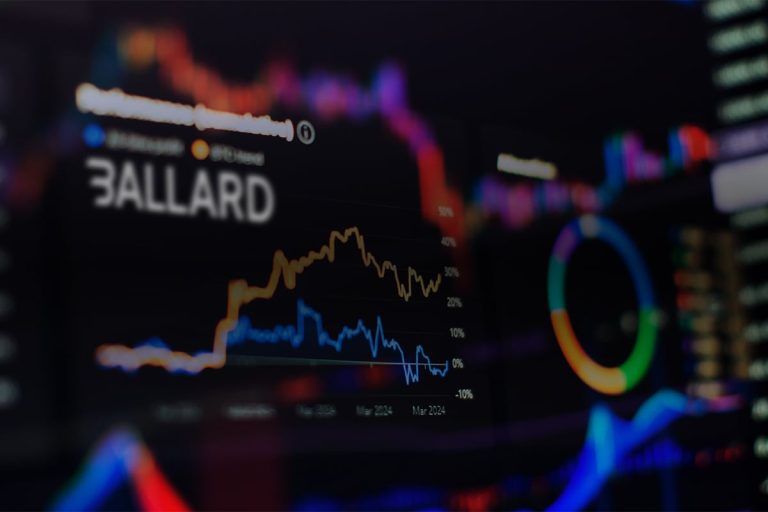BLDP Stock Key Metrics, Price Forecast
To invest in Ballard Power Systems (NASDAQ: BLDP) stock, it’s essential to perform thorough analyses of the company’s performance and stock price. This article provides key information about the company’s activities, major competitors in the market, and recent partnerships, all of which are critical for making informed decisions.
BLDP Stock News: Key Metrics and Trading Data
BLDP stock price today closed at $1.75, rising 1.74% from the previous close of $1.72.
The stock opened at $1.67, with a day’s range between $1.68 and $1.77. Over the past 52 weeks, the stock has fluctuated from a low of $1.61 to a high of $4.34.
With a market cap of $523.96 million and a beta of 1.73, Ballard Power shows higher volatility compared to the market.
However, Ballard Power remains unprofitable, with a net income of -$156.14 million and a negative EPS of -0.52.
Its revenue stands at $104.27 million, with a 4.5% year-over-year quarterly revenue growth. The company’s cash reserves of $680.14 million provide a strong buffer, and its total debt is $28.03 million.
Despite its current challenges, Ballard’s solid cash position and growth potential could make it worth watching in the renewable energy sector.
To keep up to date with Ballard Power Systems’ annual and quarterly results, the easiest way is to go to the company’s official website.
There, you will find all the group’s important press releases, annual and quarterly results publications, and other stock market data, such as the history of this company’s dividend.
If you want to make a good analysis of the price before selling or buying the Ballard Power Systems share, you should not neglect the technical analysis of this title.
To do it in good conditions, we recommend that you multiply the indicators including moving averages, MACD, stochastic, Bollinger bands, RSI or even technical support and resistance levels.
About the Company
The Ballard Power Systems Inc. group is a Canadian company specialising in technology. The group specifically designs proton exchange membrane or PEM fuel cell products.
Ballard was founded in 1979 and began developing fuel cell technology in 1989. The company went public on the Toronto Stock Exchange, or TSE, in 1993. In 1995, Ballard Power Systems shares were also listed on the Nasdaq. Since then, its stock has been listed on both financial markets simultaneously.
Its current main activity is designing, developing, manufacturing, selling, and after-sales service of PEM fuel cell products for different applications.
The group primarily focuses on energy product markets, including heavy power, portable power, material handling, and backup power. In addition, it provides technology solutions such as technical services, licensing, and the sale of its intellectual property portfolio and core knowledge for various fuel cell applications. The group currently employs 785 people.
Ballard Ballard Power Systems – Financial Performance Analysis
Ballard is making solid progress toward its key targets while benefiting from favourable regulation, potentially boosting BLDP stock. Still, investors prefer to stay on the sidelines given the current pace of adoption of hydrogen fuel technologies.
At the 2020 Investor Day, Ballard’s management outlined five key priorities:
Develop partnerships
Develop new fuel cell modules
Reduce manufacturing costs
Invest in increasing production capacity
Improve financial performance
During the last investor day in June 2024, Ballard demonstrated that it had made significant progress on four of its five objectives.
While the company could not improve its financial performance, its management stated that it aims to achieve earnings before interest, taxes, depreciation and amortisation (EBITDA) at breakeven in the second half of the decade as its revenues continue to grow and its costs decline.
Thirty countries currently have a strategy for adopting hydrogen-powered vehicles, while 23 others are in the process of adopting one. With the fight against climate change becoming a priority in many countries, we anticipate that regulation will continue to favour hydrogen, which will benefit Ballard.
Ballard currently draws most of its revenues from the bus industry, but it is easy to understand why it wants to diversify its markets and target trucking.
Trucks should eclipse buses by the end of the decade. Stationary power systems also have the potential to generate significant revenues in the coming years.
Ballard’s Main Competitors
While a good knowledge of Ballard Power Systems is important, the same is true regarding the knowledge of its main competitors on the market. Indeed, the group must face various major players in the field of fuel cells, the details of which are as follows:
Doosan Fuel Cell
This company is based in Korea and mainly specialises in manufacturing and selling fuel cells for power generation. The group produces fuel cell pipes used in power generation facilities and also provides long-term maintenance and repair services. The company is also engaged in fuel cell system design, controller development, fuel pretreatment system development, cell device and peripheral development.
Nel ASA
This Norwegian company was created in 1998 and provides solutions for producing, storing, and distributing hydrogen from renewable energy sources. The group is part of the OBX stock index on the Oslo Stock Exchange.
Hydrogenics
This company develops and manufactures hydrogen generation and fuel cell products based on water electrolysis and proton exchange membrane technology. The company operates in Belgium, Canada and Germany and has satellite offices in the United States, Indonesia, Malaysia and Russia.
Ballard Power Systems Partners
Of course, the Ballard Power Systems group can also count on some allies since it regularly sets up strategic partnerships with other companies, as in the following two examples:
Quantron
In 2021, the group notably set up a partnership with Quantron AG in the development of hydrogen fuel cell electric trucks. The two companies thus plan to bring several hydrogen electric vehicle platforms to the German market by the second half of 2022.
The platforms currently under development include a 7.5-ton delivery truck, a 44-ton heavy-duty truck and a municipal waste collection truck. Ballard is currently in its eighth generation of heavy-duty fuel cell power module experience, based on 85 million km of road services from more than 3,500 buses and trucks powered by today’s cutting-edge PEM technology.
WL Gore Associates
Earlier this year, the company agreed with WL Gore Associates to advance fuel cell tech.
The agreement is a multi-year fuel cell supply deal between the two companies. A signing ceremony was held at the 6th International Fuel Cell Vehicle Congress, celebrating their past collaborations and renewed commitment to advancing fuel cell technologies.
Final Thoughts: BLDP Stock Buy or Sell
The analyst rating consensus for Ballard Power Systems is a Moderate Sell, signifying that analysts have a cautious outlook on the stock’s future performance.
Ballard Power Systems shows potential in the renewable energy sector, especially with its focus on hydrogen technology. The company faces challenges, but its strong cash reserves and growing market opportunities in trucking and stationary power systems offer promise. Keep an eye on financial performance and progress toward key goals before making an investment decision.
The post BLDP Stock Key Metrics, Price Forecast – Is It a Buy? appeared first on FinanceBrokerage.



